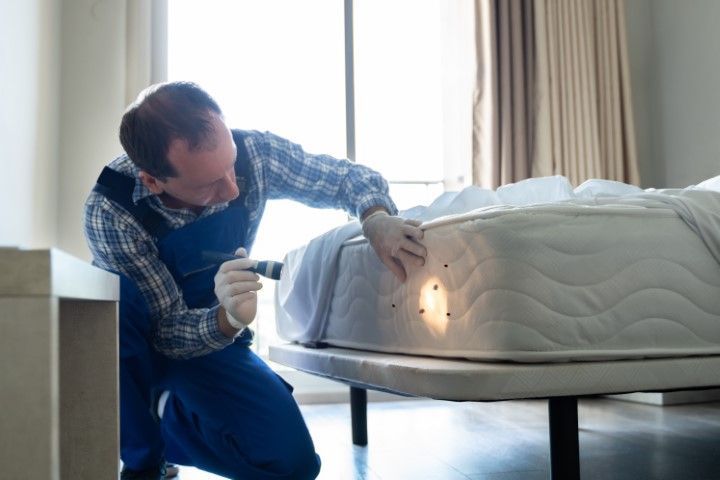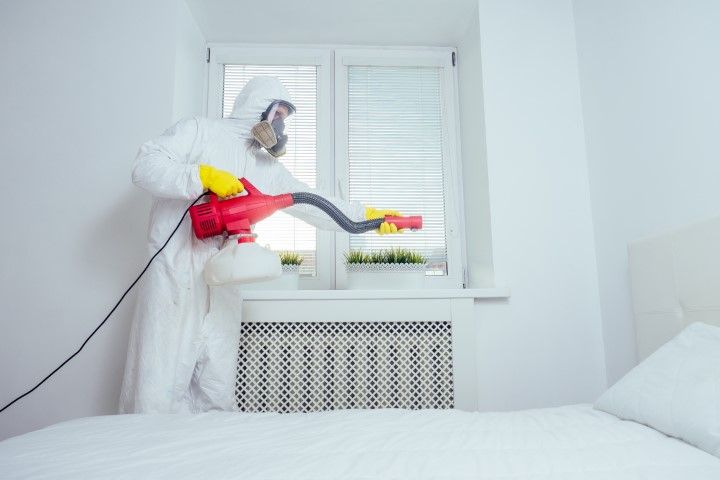Pest Guard Pro
(607) 367-6720
Bed Bug Control in Elmira NY

Contact Us
Bed bugs are small pests, but they can cause big problems. These tiny insects hide in mattresses, furniture, and cracks in the walls. They come out mostly at night to bite, leaving red, itchy spots on your skin. Getting rid of them quickly is important because they spread fast. At Pest Guard Pro, we offer a trusted and fast bed bug control in Elmira, NY to stop them before they get worse. Our goal is to remove them safely and completely so you can sleep without worry. If you’re waking up with bites or have seen small bugs on your bed or couch, it’s time to take action. With our proven method, we’re ready to help you get your home back to normal. We’ve created a four-step process that works. Our approach is simple, clear, and gets real results. Every step is done with care and safety in mind, both for your home and the people inside.
Step 1: Full Inspection
We begin with a careful look at your home. Our trained team checks all the spots where bed bugs like to hide—beds, couches, chairs, baseboards, and even electrical outlets. We also ask you some questions about what you’ve seen or felt to better understand the problem. This helps us know how big the issue is and where the pests are hiding. With this information, we build a treatment plan that fits your situation.
Step 2: Preparation Guidance
Next, we give you clear steps to prepare your home. We’ll explain how to wash your sheets, clean your clothes, and move certain items so we can reach all the right areas. This step is very important. It helps our treatment work better. We make sure you know exactly what to do before we arrive, so there’s no confusion.
Step 3: Safe and Targeted Treatment
This is the part where we get to work. We use proven methods to kill bed bugs at all life stages—eggs, nymphs, and adults. Our treatments are tough on bugs but safe for families and pets. Depending on your home’s needs, we may use heat treatments, chemical sprays, or both. Each choice is carefully made based on the size of the problem and your comfort level. We also treat nearby rooms if needed, just in case the bugs have moved.
Step 4: Follow-up and Prevention Tips
Once the treatment is done, we don’t just walk away. We return to make sure the bugs are really gone. If we find any signs of activity, we take care of it right away. We also give you simple tips to keep bed bugs from coming back. These include how to check new furniture, what to do when traveling, and how to keep your space clean and sealed.
If you think you might have a bed bug problem, don’t wait. The longer you wait, the harder it can be to fix. Call us today or send us a message. Our team is ready to help with fast and safe solutions that bring back peace of mind. We’re just one call away from helping you rest easy again.
Typical Hiding Spots of Bed Bugs
Bed bugs are tiny insects that often go unnoticed until they become a problem. They don’t fly or jump, but they crawl quickly and can hide in many places. These pests are known for feeding on human blood, usually at night while people are sleeping. Because they are so small and flat, they can squeeze into very narrow spaces. If you’ve been waking up with itchy red spots or bites, it could mean that bed bugs are nearby. Knowing where they hide is one of the first steps to getting rid of them. Let’s look at four common places where bed bugs hide.
Mattresses and Box Springs
The most common place for bed bugs to hide is in your bed—especially in the seams of your mattress and inside your box spring. They are drawn to the warmth of your body and the carbon dioxide you release while sleeping. Since you spend hours lying in one place, the bed offers the perfect feeding spot. These bugs often stay close to their food source, so it makes sense that they gather in or around your mattress. If you notice tiny black or brown spots, small white eggs, or shed skin, it’s likely you have an infestation.
Cracks in Furniture and Walls
Bed bugs love to hide in small spaces, especially cracks and crevices. That includes wooden bed frames, headboards, nightstands, and even baseboards around the room. If you live in an older home or apartment, these cracks can be easy entry points for bed bugs. Even electrical outlets or loose wallpaper can give them a place to settle. Once they get inside, they multiply quickly and can spread from room to room. That’s why it’s important to check all corners of your furniture and wall trim if you suspect you have bed bugs.
Upholstered Furniture and Curtains
Another hiding place for bed bugs is soft furniture like couches and chairs. The bugs can bury themselves deep into the cushions or slip between the seams. If you spend time sitting or lying on your couch, they might bite you without you even knowing it. Curtains, especially those that touch the floor, can also provide shelter. Bed bugs climb well, and fabric gives them a nice surface to cling to. Over time, they can move from one piece of furniture to another, making the problem worse if left untreated.
Luggage, Bags, and Clothes
Bed bugs are excellent travelers. They can latch onto your suitcase, backpack, or clothing without you realizing it. If you’ve stayed in a hotel, visited a friend’s house, or even used public transportation, there’s a chance bed bugs could have hitched a ride. Once inside your home, they’ll look for a new hiding spot—often your bed or closet. It’s a good idea to inspect your belongings after any trip and avoid placing your bags on the bed or couch.
If you’ve seen any signs of bed bugs or think you may have an infestation, don’t wait. Bed bugs spread fast and can cause stress, discomfort, and sleepless nights. Contact us today for fast and effective bed bug and termite control and prevention. Our team knows how to find and remove them from every hiding spot in your home. We’re here to help you sleep peacefully again.
How Bed Bug Infestations Start and Grow
Bed bugs are tiny pests that can cause big problems in any residential or commercial building. They are often found in beds, couches, chairs, and other furniture, but they can also live in cracks, behind picture frames, or even in electrical outlets. Though they don’t fly, they are skilled travelers and can spread quickly if not controlled early. Knowing how bed bugs spread can help you protect your home and stop an infestation before it grows worse. In this post, we’ll talk about four common ways bed bugs spread so you can stay aware and take action if needed.
Travel and Luggage
When people stay in hotels, motels, or vacation rentals, bed bugs may climb into suitcases, backpacks, or clothing. Once you bring these bags home, bed bugs can crawl out and find places to hide in your bedroom or living area. This can happen even in clean and high-end hotels. You may not notice the bugs at first, as they are small and usually hide during the day. That’s why it’s a good habit to check hotel mattresses and keep your bags off the floor or bed while traveling.
Used Furniture and Mattresses
Buying second-hand items like couches, beds, or dressers might seem like a good deal, but it can come with hidden risks. Bed bugs often hide in the seams or cracks of these items. When you bring them into your home, the bugs can crawl out and start spreading to other parts of your house. Even if the furniture looks clean, it’s best to inspect it carefully or avoid buying used bedding or mattresses from unknown sources.
Shared Living Spaces
Bed bugs can easily move from one room to another in apartments, dorms, or shared housing. If one unit has bed bugs, they may crawl through walls, vents, electrical outlets, or small gaps between floors and ceilings. This makes it easier for them to infest nearby units without anyone noticing right away. Because they are small and fast, bed bugs can spread through a building quietly and slowly until they become a larger issue. That’s why early treatment is important.
Visitors and Personal Belongings
Bed bugs can also travel with people unknowingly. Friends or guests may bring them into your home on their clothes, bags, or shoes. They may have no idea they are carrying bugs, especially if the infestation is small in their home. Once inside, the bed bugs can quickly hide in cracks, under cushions, or inside beds. The same thing can happen if you visit a place that has bed bugs and bring them home with you. Always check your items after visiting unfamiliar homes or staying somewhere overnight.
If you suspect that bed bugs have entered your home or property, don’t wait. They spread fast and can be difficult to remove without help. Contact us now for fast and reliable bed bug control. Our team is trained to find and remove bed bugs fully and safely. Let us help you protect your home and sleep peacefully again.

